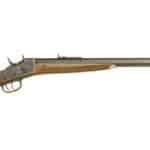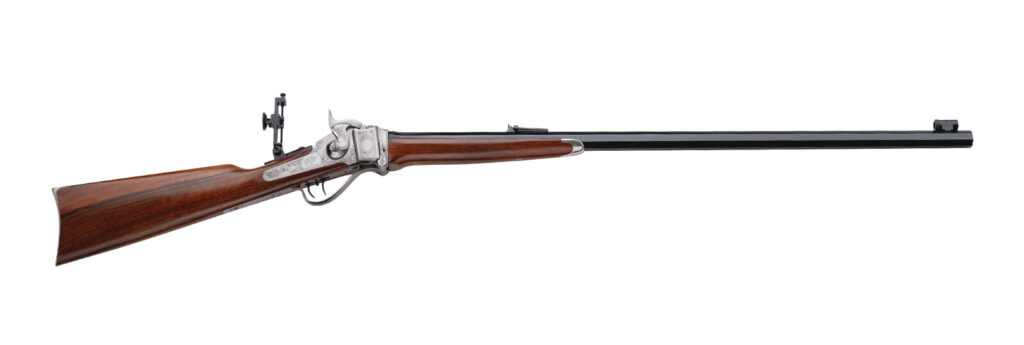
The Legendary .50-90 Sharps Cartridge: Power, Precision, and History
Introduction to the .50-90 Sharps
Few cartridges have achieved the legendary status of the .50-90 Sharps, a round synonymous with the great buffalo hunts of the American West. This black powder powerhouse was designed for one purpose—delivering devastating firepower at long range. Hunters, frontiersmen, and riflemen of the 19th century depended on its brute force to take down massive game, and its legacy continues today among long-range shooters and historical firearms enthusiasts.
From its original use in the Sharps Model 1874 to its role in modern precision black powder shooting, the .50-90 remains a fascinating chapter in American firearms history. Let’s dive deep into its dimensions, performance, historical significance, and continued relevance in the shooting world.
Cartridge Specifications and Ballistics
The .50-90 Sharps derives its name from its .50 caliber bullet and original charge of 90 grains of black powder. Though its nominal caliber is .50, the actual bullet diameter measures .512 inches, a common practice of the era where naming conventions were often approximate. The case length is 2.50 inches (2 1/2 inches), and its overall loaded cartridge length can reach up to 3.25 inches, depending on the bullet weight and seating depth.
Variations and Similar Cartridges
The .50-90 was part of a family of large-caliber Sharps cartridges, including:
- .50-100 Sharps: Used the same case but loaded with a lighter bullet at a higher velocity.
- .50-110 Sharps: Similar to the .50-100 but optimized for even greater speed.
- .50-140 Sharps: A later development with a 3.25-inch case, capable of holding up to 140 grains of black powder for maximum power.
The .50-90 offered the best balance of power, accuracy, and manageable recoil, making it the choice of many professional buffalo hunters.
Bullet Weights and Types
Traditional bullet weights for the .50-90 ranged from 425 grains to 600 grains, with 473 grains being a standard load. While modern options range from 300 to 700 grains, heavier bullets are preferred for long-range energy retention and penetration. Bullet types include:
- Lead cast bullets: The historical standard, often in paper-patched or grease-grooved designs.
- Gas-checked bullets: Reduces fouling and enhances velocity in some configurations.
- Modern jacketed bullets: Available for those who handload with smokeless powders.
Powder Charges: Black Powder vs. Smokeless Powder
Originally, the .50-90 was loaded with 90 grains of black powder, a volumetric measurement rather than exact weight. Different granulations of black powder, such as FFg or FFFg, influence burn rate and pressure.
Modern Reloading with Smokeless Powder
While traditionalists stick to black powder, modern reloaders use smokeless powders for enhanced consistency and reduced fouling. Popular choices include:
- Accurate 5744
- IMR 4198
- Reloder 7 (RL-7)
Smokeless loads typically range from 70 to 85 grains, carefully adjusted to avoid excessive pressure. Consulting up-to-date reloading manuals is crucial when working with non-traditional loads.
History and Performance in the Buffalo Hunting Era
The .50-90 Sharps was introduced in the early 1870s for use in the Sharps Model 1874 rifle. It quickly became the go-to choice for professional buffalo hunters who needed a round capable of taking down a 2,000-pound bison with a single well-placed shot at extended ranges.
The Buffalo Hunting Boom (1870-1875)
During the peak of the Great Plains buffalo hunts, marksmen like Billy Dixon and Frank Mayer relied on large-caliber Sharps rifles. These skilled hunters often took shots at distances exceeding 500 yards, with some remarkable kills recorded past 1,000 yards.
Billy Dixon's legendary "Shot at Adobe Walls" in 1874—where he allegedly killed a Comanche warrior at over 1,500 yards—was made with a similar .50-90 class rifle, demonstrating the cartridge’s extreme range capability.
Muzzle Velocity and Energy
Performance of the .50-90 varied based on load, but typical ballistics include:
- Black Powder Load (90 grains FFg, 473-grain bullet): ~1,350 fps
- Heavy Black Powder Load (100 grains FFg, 600-grain bullet): ~1,200 fps
- Modern Smokeless Load (IMR 4198, 550-grain bullet): ~1,500 fps
With muzzle energy ranging from 3,000 to 4,000 ft-lbs, the .50-90 packed enough power to drop the largest game in North America.
Firearms Chambered for the .50-90
Historic Models
- Sharps Model 1874: The definitive rifle for the .50-90, used by professional hunters.
- Sharps Model 1877 & 1878: Variants built with improved materials and action refinements.
Modern Production Rifles
For enthusiasts today, several manufacturers produce faithful reproductions of the classic Sharps rifles:
- Shiloh Sharps
- C. Sharps Arms
- Pedersoli Sharps
These high-quality single-shot rifles are built for authentic black powder shooting and long-range competition.
What Replaced the .50-90?
As smokeless powder revolutionized firearms, rounds like the .45-70 Government and .50 BMG rendered the .50-90 obsolete for military and frontier use. However, the cartridge still enjoys a strong following among long-range black powder shooters and big-game hunters.
Modern Applications: Hunting and Competition
While it’s no longer the dominant force it once was, the .50-90 remains revered among hunters and long-range black powder competitors.
Hunting Applications
Some modern bison and bear hunters prefer the .50-90 for its ability to deliver a clean, ethical kill on large game. Unlike high-velocity modern rounds, the heavy low-velocity bullets penetrate deep without excessive meat destruction.
Competitive Shooting
The .50-90 sees continued use in Black Powder Cartridge Rifle (BPCR) silhouette matches and long-range shooting competitions, where marksmen test their skills on targets up to 1,000 yards away using iron sights.
Conclusion: A Cartridge of Immense Power and Legacy
The .50-90 Sharps is more than just a relic of the Old West—it is a testament to a time when cartridges were built for survival, sustenance, and frontier warfare. With a rich history, modern-day relevance, and a dedicated following, it remains one of the most iconic black powder cartridges of all time. Whether used for hunting, competitive shooting, or historical reenactment, the .50-90 continues to command respect among marksmen who appreciate its raw power and enduring legacy.
Read more about the .50-90 and other cartridges here:

If you know of any forums or sites that should be referenced on this listing, please let us know here.



